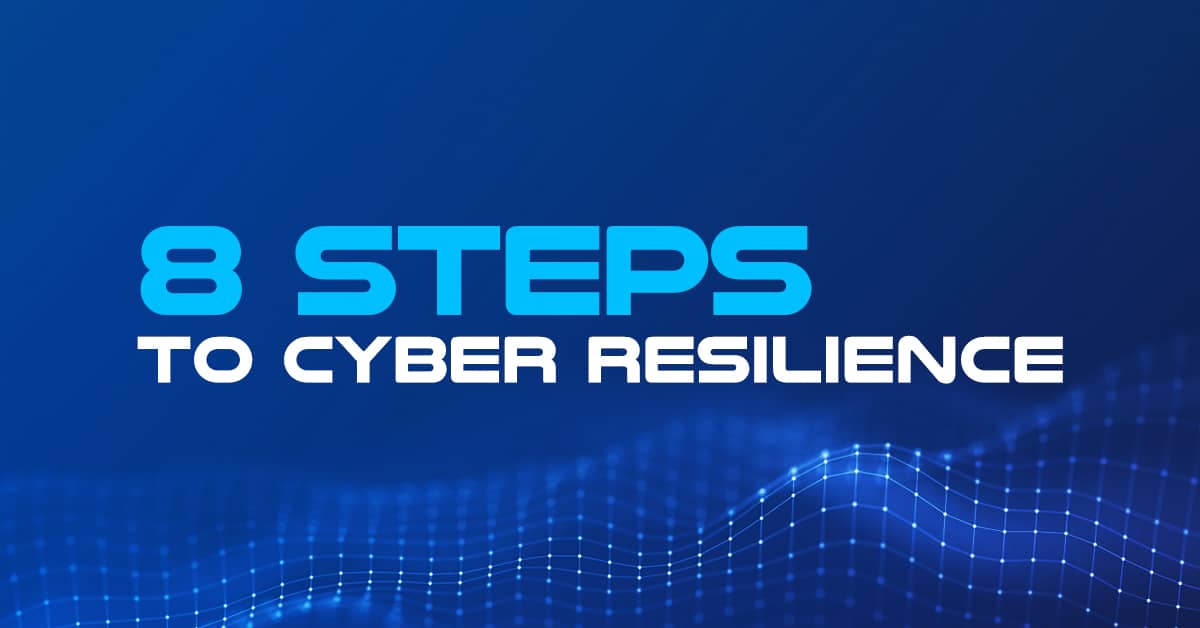READ TIME: 4 MIN
Cyber Security: 8 Steps to Cyber Resilience
You’ve heard of cyber security, but have you heard of cyber resiliency? Let’s start with definitions:
Cybersecurity includes the technologies and measures utilized to thwart cyber threats.
Cyber resilience is the ability to maintain business operations despite a cyber attack or breach.
No cybersecurity solution is infallible. Cyber resilience involves the understanding that a security threat will eventually penetrate network systems and a robust business will have proactively prepared processes and methods to minimize damage and ensure business continuity. Both cyber security and cyber resilience are essential to protecting the bottom line, productivity, and brand reputation of a business. With a 69% increase in internet crime in 2020 and a 40-60% chance that a small business will never reopen after data loss, both cyber security and cyber resilience are critical to a company’s endgame. Let’s breakdown 8 steps businesses must take to optimize cyber security and cyber resilience strategies.Cybersecurity
Vulnerability Assessment
Perform a comprehensive analysis of business assets to identify gaps or weaknesses that cyber criminals can exploit. Use tools and techniques, including infrastructure penetration testing, to scan for vulnerabilities and assess their potential impact. The findings and their necessary mitigations will guide the rest of your security and resiliency journey.
Defensive Barriers
Shore up weaknesses with the first line of defense, including antivirus protection and firewalls; remember to keep software updated and deploy regular patches. Spam filters decrease the social engineering attacks upon fallible employees. Multi-Factor Authentication (MFA) adds an extra layer of identification to stop cyber threats from slipping through unsecured devices.
Security Awareness Training
Despite cyber defenses, phishing attempts will still slide into inboxes. In a 2020 survey, 89% of Americans thought they were good at cybersecurity but only 10% received an ‘A’ grade. With 23% of data breaches caused by human error, companies must invest in training to help employees identify common social engineering tactics and how to report them.
Proactive monitoring
Cybersecurity demands vigilance. A business must continuously maintain infrastructure and eliminate vulnerabilities with frequent updates. IT teams must proactively monitor network systems and alerts for potential cyber threats. If a security threat breaches the cybersecurity defenses, then hopefully the business has prepared adequate cyber resilience.
Cyber Resilience
Risk Assessment
An enterprise risk management framework assesses potential risks or scenarios that can negatively impact a project or business. The three-step process of risk identification, analysis, and evaluation provides a foundation for the development of business continuity and disaster recovery plans to maintain operations during an internal or even external crisis.
Incident Response Plan
In the event of a cyber breach, a previously tested incident response plan can save up to $2 million, according to IBM. The plan outlines what to do during a system failure or breach; who is responsible for such duties; how to inform team members and customers; and how to assess the effect of any defensive and responsive measures to improve them against future attacks. A well-tested incident response plan can reduce the time needed to identify and contain a data breach by 74 days.
Business Continuity Plan
Another essential proactive plan is the BCP, a set of processes and policies for various circumstances to ensure an organization remains functional despite a crisis. 90% of companies that are unable to recover business operations within five days of a disaster fail within a year, and yet only 49% of companies have a business continuity plan. From automating processes to data restore, a BCP can make all the difference.
Disaster Recovery Plan
A subset of the BCP, the disaster recovery plan focuses on minimizing damage and restoring the data and information systems of a business. Data should be frequently backed up and preferably stored at an offsite location so that it can be restored promptly in the event of a disaster and prevent data loss. A robust BC/DR plan promotes a swift rebound and improves business uptime, no matter the crisis.
While essential to protect your business, cybersecurity is not enough on its own to guarantee your organization doesn’t sink in the storm or its aftermath. Building cyber resilience ensures your business rolls with the waves. Your IT department may have super cyber defense measures but an outdated or even nonexistent business continuity plan, or vice versa. Checking off all 8 cybersecurity and cyber resilience steps from the to do list takes a full-fledged team with bandwidth for proactive maintenance, monitoring, and testing.
Many companies, particularly small and medium-sized businesses, do not have the personnel headcount, expertise, or time to fulfill all 8 steps. NexusTek’s certified engineers can augment your IT team and provide some or all of the criteria for healthy cybersecurity and cyber resilience. As an award-winning managed service provider, NexusTek helps businesses across the U.S stay vigilant and improve resilience.







